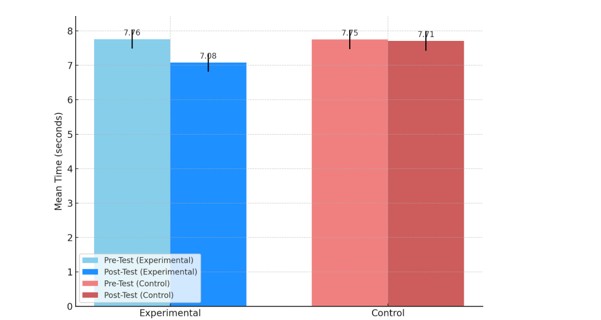SPEED ENHANCEMENT THROUGH COMBINED PLYOMETRIC AND SKILL TRAINING: AN 8-WEEK STUDY ON BEGINNER FENCERS
DOI:
https://doi.org/10.60081/SSHA.3.1(Spl).2025.487-492Keywords:
Plyometric training, Fencing drills, 50-Meter Dash, Speed development, Beginner fencers, AAHPER, ANCOVAAbstract
This study investigates the impact of an 8-week plyometric-weight training and fencing-specific skill training program on the speed of beginner fencers aged 10–19 years from Karnal District, Haryana. Sixty beginner fencers were purposively selected and randomly divided into two equal groups: an experimental group (n=30) receiving the integrated training program, and a control group (n=30) undergoing standard fencing training. The 50-Meter Dash Run Test from the AAHPER Youth Physical Fitness Test (1976) was used to assess speed before and after the intervention. Descriptive statistics revealed a significant improvement in post-test speed scores for the experimental group (M=7.08, SD=0.26) compared to the control group (M=7.71, SD=0.29). ANCOVA results demonstrated a statistically significant difference between the groups (F=137.42, p<0.001), with post hoc analysis indicating a mean difference of -0.63 seconds (p<0.001) favoring the experimental group. The results confirm that a combined plyometric-weight and skill-specific training regimen is effective in improving speed performance among beginner fencers. This research underlines the importance of targeted physical conditioning programs for youth athlete development.
References
1. AAHPER. (1976). AAHPER Youth Fitness Test Manual. Washington, D.C.: American Alliance for Health, Physical Education, and Recreation.
2. Aakash, Sisodia, A., Kumar, A., & Jain, I. (2023). Patanjali’s Ashtanga Yoga: A bibliometric analysis of its impact on health and well-being. Journal for ReAttach Therapy and Developmental Diversities, 6(1), 1003–1013.
3. Chu, D. A. (1998). Jumping into Plyometrics (2nd ed.). Human Kinetics.
4. Faigenbaum, A. D., Bellucci, M., Bernieri, A., Bakker, B., & Hoorens, K. (2005). Acute effects of different warm-up protocols on fitness performance in children. Journal of Strength and Conditioning Research, 19(2), 376–381.
5. Ford, P. R., et al. (2011). The long-term athlete development model: Physiological evidence and application. Journal of Sports Sciences, 29(4), 389–402.
6. Gautam, R. K., & Kumar, A. (2018). Effects of deprivation of sleep on the catching accuracy in cricket. International Journal of Physiology, Nutrition and Physical Education, 3(2), 14–16.
7. Jadaun, R., Kumar, D. A., Singh, D., & Sisodia, D. A. (2021). A comparative study of Covid-19 pandemic on mental toughness of national level players of selected team games. Natural Volatiles & Essential Oils, 8(6), 6583–6587.
8. Jain, I., Sisodia, A., Kumar, A., & Aakash. (2023). Yoga as a viable non-pharmacological approach for primary dysmenorrhea: An in-depth review and meta-analysis. Journal for ReAttach Therapy and Developmental Diversities, 6(1), 1014–1025.
9. Khare, S., Reddy, T. O., Kumar, A., & Sisodia, A. (2023). Muscle architecture and sports performance. International Journal of Physiology, Nutrition and Physical Education, 4(2), 254–257.
10. Kumar, A. (2018). Effect of deprivation of sleep on handball shooting accuracy. International Journal of Physiology, Nutrition and Physical Education, 3(1), 2075–2077.
11. Kumar, A. (2022). Relationship between quadriceps muscle fiber architecture and lunges performance. International Journal of Physiology, Nutrition and Physical Education, 7(2), 347–351.
12. Kumar, A. (2023a). Muscle architecture: A new dimension of talent identification – A mini review. International Journal of Applied Research, 9(1), 142–146.
13. Kumar, A. (2023b). Muscle fiber type estimation through muscle architectural properties. Unpublished manuscript or pending source information.
14. Kumar, A. (2023c). Non-invasive estimation of muscle fiber type using ultrasonography. International Journal of Physical Education, Sports and Health, 10(1), 89–95.
15. Kumar, A., & Jhajharia, B. (2018). Effect of morning exercise on immunity. International Journal of Physiology, Nutrition and Physical Education, 3(1), 1987–1989.
16. Kumar, A., & Jhajharia, B. (2020). Lunges performance predicted by multiple linear regression model with muscle architectural parameters. Turkish Online Journal of Qualitative Inquiry, 11(4), 2510–2517.
17. Kumar, A., & Jhajharia, B. (2022). A comparative study of white muscle and red muscle fiber architectural parameters. Asian Pacific Journal of Health Sciences, 9(3), 46–49.
18. Kumar, A., Khare, S., & Sisodia, D. A. (2021). An aerobic capacity variable-based discriminant model for the classification of handball players. Natural Volatiles & Essential Oils, 8(6), 6544–6548.
19. Markovic, G. (2007). Does plyometric training improve vertical jump height? A meta-analytical review. British Journal of Sports Medicine, 41(6), 349–355.
20. Miller, M. G., et al. (2006). The effects of a 6-week plyometric training program on agility. Journal of Sports Science and Medicine, 5(3), 459–465.
21. Myer, G. D., et al. (2005). The effects of plyometric versus dynamic stabilization and balance training on lower extremity biomechanics. American Journal of Sports Medicine, 34(3), 445–455.
22. Nandal, A., & Kumar, A. (2024). A comparative analysis of lower limb explosive strength between judo and Kho-Kho players. Journal of Sports Science and Nutrition, 5(1), 25–26.
23. Thomas, K., French, D., & Hayes, P. R. (2009). The effect of two plyometric training techniques on muscular power and agility in youth soccer players. Journal of Strength and Conditioning Research, 23(1), 332–335.
24. Young, W. B., Dawson, B., & Henry, G. J. (2015). Agility and change-of-direction speed are independent skills. International Journal of Sports Science & Coaching, 10(1), 159–169.

Downloads
Published
Issue
Section
License
Copyright (c) 2025 Usha Rani, Ankit

This work is licensed under a Creative Commons Attribution 4.0 International License.







